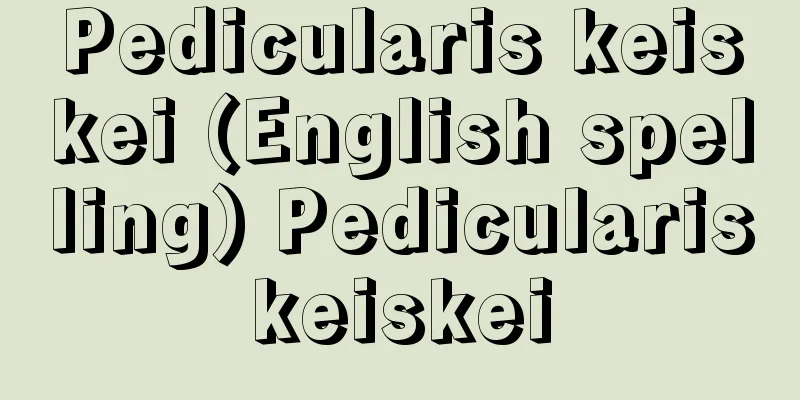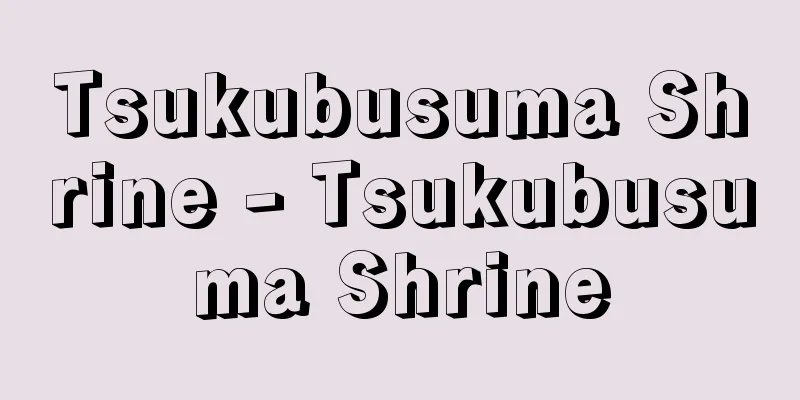Primitive art

|
A translation of primitive art. The word primitive can mean early, archaic, or primordial, as well as uncivilized or simple. Therefore, in art history, the word primitive is used to refer to prehistoric art, art from existing tribal societies, art from just before the Renaissance, and modern naive paintings. When used specifically, it refers to prehistoric art and art from tribal societies, but because the two are different in nature, the former is sometimes called prehistoric art or primaeval art and the latter tribal art to distinguish them. [Shigenobu Kimura] European Prehistoric ArtIt was during the Late Paleolithic that humans began to create artworks such as paintings and sculptures. That is, from the Aurignacian period about 30,000 years ago, through the Périgordian and Solutrean periods, to the end of the Magdalenian period about 10,000 years ago, cave paintings and engravings, rock reliefs, and movable art (small objects made of stone, bone, horn, and clay) were created all over Europe. Many of the ruins are concentrated in the mountainous region of southern France and the Cantabric Mountains of northern Spain, so it is also called Franco-Cantabrian art. There are about 100 cave art ruins, including Lascaux, Pech-Merles, Niaux, and Les Trois Frères in France, Altamira and El Castillo in Spain, and Levanzo in Italy. The subjects of the cave paintings are concentrated on animals that were particularly desirable to capture, such as cows, horses, bison, deer, and goats, and there are no attempts to depict mountains, rivers, vegetation, and trees. Human figures are rare, and when they do appear, they are half-human, half-animal. In contrast, the rock reliefs, found only in the Charente and Dordogne regions of France, show human figures in natural poses, but they are all female, naked, and with greatly exaggerated breasts, bellies, and buttocks. This emphasis on feminine features is also common to nude female figures carved in the round, and, in conjunction with the lack of clearly defined male figures, these nude female figures are thought to be related to fertility magic. This desire for fertility or reproduction is expressed in the animal figures in cave paintings and rock reliefs, which are depicted as fleshy, mature figures, or pregnant females. In contrast, animal figures are depicted as wounded or in pitfalls, which are associated with murder magic. In addition to the aforementioned carved nude female figures, the movable art also includes carved animal figures, magic sticks, javelin throwing devices, and painted or engraved pebbles with sketches for painting practice; among these, too, expressions related to the magic of reproduction or murder can be found. Around 10,000 years ago, the climate warmed and the Middle Stone Age began. Among the artistic remains of this period are Levantine art and Far North art. Levantine art is widely distributed in eastern Spain, and there are about 40 ruins, all of which are painted in monochromatic red or black on the walls in the shade of rocks. Animal figures are realistic, while human figures are highly stylized, but there are many scenes that combine the two, such as hunting and dancing. In addition to wild beasts, animal figures include insects such as spiders, bees, and flies, and rarely domesticated dogs. The size of these painted animal figures is 80 cm, and few human figures exceed 30 cm. Far North art refers to rock carvings distributed in Scandinavia and northern Russia. They were created by hunter-fisher people from the 6th millennium BC to the middle of the 2nd millennium BC, and have a naturalistic style. The subjects include animal figures such as reindeer, deer, seals, whales, and salmon, as well as stylized human figures and abstract shapes. The expression techniques include carvings of outlines with a single line and engravings made using the hammer and hammer technique. Some animal figures are as large as 7 to 8 meters, but generally speaking, early animal figures were mostly life-size carvings, and the figures became smaller over time. During the Neolithic period, which began around the 4th millennium BC, and the Bronze Age that followed, megalithic structures were built in the Mediterranean islands, Spain, Portugal, France, the British Isles, Denmark, northern Germany, southern Scandinavia, and elsewhere, with some regional differences. Dolmens, menhirs, alignments (such as Carnac in France), cromlechs (such as Stonehenge in England), and menhir figures, reliefs of male or female figures, were created in parts of France. Also, highly abstracted schematic rock paintings were created in the Iberian Peninsula and southern Scandinavian peninsula. [Shigenobu Kimura] African prehistory and tribal artRock paintings and carvings are widely distributed in the deserts of the Sahara, Libya, and Sudan, as well as in the Atlas Mountains. They remain in mountainous areas such as Tassili n'Ajjer, South Oran, and Ahaggar in Algeria, Adrar des Jifolas in Mali, Aïr in Niger, Tibesti and Ennedi in Chad, and Fezzan in Libya, and have been produced from the Mesolithic period to the present. Over those several thousand years, natural conditions have changed, ethnic groups have been replaced, and lifestyles have changed, so have the themes and styles of the rock paintings. (1) Archaic Period: Mesolithic carvings of large, single animals such as elephants, buffaloes, and antelopes. (2) The Hunter-Hunter Period (c. 6000 BC to c. 4000 BC) These Neolithic rock paintings depict people with round heads and wild animals, and the artists are thought to be of Negroid descent. (3) The Age of Cattle (up to around 1500 BCE) These rock paintings date to the time when cattle and sheep were raised, and are thought to have been made by the Fulbe people. (4) Age of the Horse (~200 B.C.) These rock paintings date back to the time when the Sahara region began to dry up and horses were brought from Asia. There are conflicting theories about the creators, namely the Garamantes theory and the Libyan theory. (5) The Camel Era Rock paintings from around 200 BC, when camels were introduced to the Sahara, to the Arab invasion period. The Tifinagh script appears, and the artists are Tuareg people. (6) Arabo-Berber Period This period belongs to the period of coexistence between Muslim Arabs and Berbers, which dates from the 11th century onwards. While the artists of the rock art in northern Africa changed hands one after another, the vast number of painted and engraved rock art in southern Africa were created by a single tribe, the San (formerly known as the Bushmen), from the 5th millennium BC until the 19th century. Painted art sites are found in mountainous areas such as Zimbabwe, the Drakensberg, Natal, the Cape and the Brandberg, while engraved art sites are found in the grasslands of the Orange Free State and the Transvaal. These rock art sites reflect the hunter-gatherer lifestyle of the San people, and themes include wild animal hunting, dancing, fighting and music, but in the later period, black people herding cattle and white people riding horses with guns were depicted. The stylistic transitions are complex, but broadly speaking, they progressed from early outline paintings to monochrome, two-colour, polychrome and polychrome with light and shade. Nigeria boasts the highest quality and quantity of ancient sculpture in Black Africa. These include Nok art, such as terracotta human figures made between 500 BC and 200 AD, highly realistic bronze portrait sculptures made at the court of the Yoruba religious city of Ife (c. 1000-1400) known for their excellent casting techniques and high artistic quality, and art from the Bini kingdom of Benin (c. 1300-1897), which is characterized by bronze and brass figures in the round or in relief. The Nupe people also produced stone Esie sculptures. African tribal art is dominated by sculptures such as masks and ancestral figures, many of which are used for rituals related to coming of age, agriculture, justice, death, etc., and are structurally very solid and highly tactile. [Shigenobu Kimura] Prehistoric Art of IndiaThere are many rock shelters in the mountainous region of central India, mainly in Madhya Pradesh, where a huge number of rock paintings are found. The area in which they are distributed forms an inverted triangle, scattered between the Chembal River Basin in the west, Varanasi in the east, and the Mahadeo Mountains in the south. They have been painted for about 10,000 years, from the Mesolithic period to the present, and the themes and styles change with the era. They all feature themes closely related to daily life, such as hunting, gathering, and fighting, and the artists are thought to be non-Aryan Beddic tribal groups that have been stagnant in this region for a long time. It is the largest group of rock paintings in the world, and discovery is still ongoing. [Shigenobu Kimura] Tribal art of OceaniaThe Australian aborigines have been producing rock paintings and engravings based on their hunter-gatherer lifestyle since ancient times, but now they also paint eucalyptus bark paintings. The main subjects are mythological beings and totem animals, and sometimes they depict scenes from funerals and hunting. They also paint magical designs on turingas (ritual sticks), boomerangs, spears, shields, and skulls. The main subjects of tribal art in Melanesia, Polynesia, and Micronesia are also mythological beings based on ancestor worship. New Guinea is a treasure trove of tribal art, and there are many excellent pieces in particular around Heerhink Bay, Lake Sentani and Humboldt Bay, the Sepik River basin, and Huong Bay. These Oceanian masks and ancestral statues are full of unrestrained imagination and colorful decoration due to the marine environment and strong sunlight, and are very visual in contrast to the tactile African sculptures. [Shigenobu Kimura] American Prehistoric and Tribal ArtNative American art is as diverse as their environments, lifestyles, and languages. The center of artistic activity is the Northwest Coast, where fishing peoples such as the Tlingit, Haida, Tsimshian, Kuwakiutl, Nootka, and Salish have created unique themes such as people, animals, birds, and mythical monsters on buildings, totem poles, large canoes, wooden boxes, and masks. There are also many rock carvings and some rock paintings being discovered in the western United States and South America. These rock paintings are relatively recent, but some, such as the paintings in the Toquepala rock shelter in Peru, date back to the Mesolithic period. [Shigenobu Kimura] "The Origin of Art" by Shigenobu Kimura (1971, Shinchosha)" ▽ "The World Art Series 1: Prehistory, African and Oceanian Art" edited by Shigenobu Kimura (1973, Gakken)" ▽ "The Beauty of Eternal Return: Notes on an Exploration of Archaic Art" by Shigenobu Kimura (1979, Kodansha)" Source: Shogakukan Encyclopedia Nipponica About Encyclopedia Nipponica Information | Legend |
|
プリミティブ・アートprimitive artの訳語。プリミティブという語には、初期、古風、始原という意味と、未開、素朴という意味とがある。したがって美術史上プリミティブという語は、先史時代の美術、現存の部族社会の美術、ルネサンス直前の美術、近代の素朴派絵画などに冠して用いられる。とくに限定して用いられる場合は、先史時代の美術と部族社会の美術とをさすが、二つは性格が異なっているので、前者を先史美術prehistoric artないし始原美術primaeval art、後者を部族美術tribal artと名づけて区別することがある。 [木村重信] ヨーロッパの先史美術人類が絵画や彫刻のような美術作品をつくり始めたのは後期旧石器時代である。すなわち約3万年前のオーリニャック期から、ペリゴール期やソリュートレ期を経て、約1万年前のマドレーヌ末期まで、ヨーロッパ各地で洞窟(どうくつ)彩画・刻画、岩陰浮彫り、動産美術(石、骨、角、土製の小美術品)がつくられた。多くの遺跡が集中しているのは南フランスの山地と北スペインのカンタブリカ山脈であるので、フランコ・カンタブリア美術Franco-Cantabrian artともよばれる。洞窟美術遺跡には、フランスのラスコー、ペシュ・メルル、ニオー、レ・トロワ・フレール、スペインのアルタミラ、エル・カスティーリョ、イタリアのレバンツォなど、約100か所がある。洞窟壁画の主題はその捕獲がとくに望まれた動物、たとえば牛、馬、バイソン、シカ、ヤギなどに集中していて、山川草木を表す試みが全然みられない。人物像もまれで、たとえ表されても半人半獣の姿をとる。これに反し、フランスのシャラント地方とドルドーニュ地方にだけ分布する岩陰浮彫りには、人物が自然の姿で表されるが、すべて女性で、しかも裸であり、また乳房、腹、臀(しり)が著しく誇張される。このような女性的特徴の強調は丸彫りの女性裸像にも共通しており、明白な男性像がみいだされないこととも関連して、これらの女性裸像は多産の呪術(じゅじゅつ)にまつわると考えられる。このような多産ないし繁殖の願望は、洞窟壁画や岩陰浮彫りの動物像が肉づきのよい成熟した姿で表現されることや、身重の雌(めす)の表現となって現れる。これとは逆に、傷を負った動物像や落し穴に陥った動物像が表されるが、これらは殺害の呪術と関連する。動産美術には前述の丸彫りの女性裸像のほか、丸彫りの動物像、呪術棒、投槍器(とうそうき)、絵画練習のためのスケッチを施した彩色または線刻の小石があるが、これらのなかにも繁殖ないし殺害の呪術にまつわる表現がみいだされる。 約1万年前に気候が暖化して中石器時代に入るが、この時代の美術的遺品にはレバント美術Levant artや極北美術がある。レバント美術は東スペインに広く分布し、約40か所の遺跡があるが、いずれも岩陰の壁面に赤または黒の単彩で描かれている。動物像は写実的に、人物像は著しく様式化されて表されるが、両者が結合した狩猟や舞踊などの情景表現が多い。動物像には野生の獣のほかにクモ、ミツバチ、ハエなどの虫類、まれに家畜化されたイヌがみいだされる。これらの彩画のサイズは、動物像では80センチメートル、人物像では30センチメートルを超えるものは少ない。極北美術とはスカンジナビアや北ロシアに分布する岩面刻画のことである。紀元前六千年紀から前二千年紀の中ごろにかけて狩猟・漁労民が制作し、自然主義的な様式をもつ。主題はトナカイ、シカ、アザラシ、クジラ、サケなどの動物像、図式化された人物像、抽象的な図形などである。表現技法は1本の線で輪郭を刻んだものと、敲打(こうだ)法による刻画とがある。動物像には7~8メートルに及ぶ大きなものがあるが、一般的にいって、初期の動物像は実物大の刻画が多く、時代の経過に伴って形象は小さくなる。 地域によって多少の年代差はあるが、前四千年紀ごろに始まる新石器時代と、それに続く青銅器時代に、巨石建造物が地中海の島々、スペイン、ポルトガル、フランス、イギリス諸島、デンマーク、北ドイツ、南スカンジナビアなどに構築された。ドルメン、メンヒル、アリニュマン(フランスのカルナックなど)、クロムレック(イギリスのストーンヘンジなど)のほか、女性または男性の姿を浮彫りしたメンヒル人像がフランスの一部でつくられた。また、イベリア半島やスカンジナビア半島南部では、きわめて抽象化された図式的岩面画が制作された。 [木村重信] アフリカの先史時代と部族社会の美術サハラ、リビア、スーダンの各砂漠やアトラス山中に岩面彩画・刻画が広く分布している。アルジェリアのタッシリ・ナジェール、南オラン、アハガル、マリのアドラル・デ・ジフォラス、ニジェールのアイル、チャドのティベスティ、エネディ、リビアのフェザンなどの山岳地帯に遺存し、中石器時代から最近まで制作し続けられた。その数千年間には自然条件の変化、民族の交代および生活様式の変化があり、したがって岩面画の主題や様式も変遷した。 (1)古拙(こせつ)時代 ゾウ、スイギュウ、レイヨウなどが単独に大きく刻まれた中石器時代の刻画。 (2)狩猟民の時代(前6000年ごろ~前4000年ごろ) 丸い頭部をもつ人物や野生動物を描いた新石器時代の岩面画で、作者はネグロイド系の人々であると考えられる。 (3)牛の時代(~前1500年ごろ) 牛および羊の牧畜が行われたころの岩面画で、作者はフルベFulbe人と思われる。 (4)馬の時代(~前200年ごろ) サハラ地域が乾燥し始め、馬がアジアからもたらされた時代の岩面画。作者についてはガラマンテスGaramantes人説とリビア人説が対立する。 (5)ラクダの時代 サハラにラクダがもたらされた前200年ごろからアラブ人の侵入期までの岩面画。ティフィナグTifinagh文字が現れ、作者はトゥアレグTuaregs人である。 (6)アラボ・ベルベルArabo-Berber時代 イスラム教徒であるアラブ人とベルベル人の共存時代のもので、11世紀以後に属する。 このように北部アフリカの岩面画の作者は次々に変わったが、南部アフリカの各地に広く分布する膨大な岩面彩画および刻画は、サン(かつてはブッシュマンとよばれた)という単一の種族によって、前五千年紀から19世紀まで描き続けられた。彩画遺跡はジンバブエ、ドラケンスバーグ(ドラケンスベルク)、ナタール、ケープ、ブラントベルクなどの山岳地帯に多く、刻画遺跡はオレンジ自由州やトランスバールの草原地帯に多い。これらの岩面画はサンの人々の狩猟採集生活を反映して、主題は野生動物の狩猟、舞踊、戦闘、音楽の演奏などであるが、末期には牛を飼う黒人や、馬に乗って銃を構える白人が表される。様式変遷は複雑であるが、大まかにいって、初期の輪郭画から単彩画、二彩画、多彩画、明暗表現を伴う多彩画へと発展する。 ナイジェリアにはブラック・アフリカ随一の質と量を誇る古い彫刻がある。前500年ごろから後200年ごろにかけてつくられたテラコッタ人像などのノク美術Nok art、ヨルバYoruba人の宗教都市イフェの宮廷でつくられ、卓越した鋳造技術と高い芸術性で知られる非常にリアリスティックな青銅製の肖像彫刻(1000年ごろ~1400年ごろ)、青銅および真鍮(しんちゅう)の丸彫りないし浮彫りの人物像に代表されるビニBini人のベナンBenin王国の美術(1300年ごろ~1897年)などである。また、ヌペNupe人はエシエEsieの石像彫刻を制作している。 アフリカの部族美術は仮面や祖霊像などの彫刻が圧倒的に優勢である。これらの彫刻の多くは成年、農業、司法、死などに関する儀式の際に用いられるが、造形的にはきわめて堅牢(けんろう)な印象を与え、非常に触覚的である。 [木村重信] インドの先史美術マディヤ・プラデシュ州を中心とする中部インドの山岳地帯に多くの岩陰があり、それらに膨大な岩壁画が描かれている。その分布地域はほぼ逆三角形を呈し、西はチェンバル川盆地から東はワーラーナシ、南はマハーデオ山地の間に散在する。それらは中石器時代から最近まで、約1万年にわたって描き続けられてきたが、時代によって主題や様式が変化する。狩猟、採集、戦闘など、生活と密着した主題ばかりで、作者はこの地方に長く停滞した、非アーリアのベッダ系の部族集団であると考えられる。世界最大の岩壁画群で、発見は現在も進行中である。 [木村重信] オセアニアの部族美術オーストラリア先住民のアボリジニーAboriginesは、古くから狩猟採集生活に基づく岩面彩画・刻画を制作し続けてきたが、現在はユーカリの樹皮絵画を描く。主題は神話的存在やトーテム動物などを主とし、ときには葬儀や狩猟などの光景を描く。ほかにチューリンガ(祭儀棒)やブーメラン、槍(やり)、盾、頭蓋骨(ずがいこつ)に呪術的な文様を描く。メラネシア、ポリネシア、ミクロネシアの部族美術のおもな主題も、祖先崇拝に基づく神話的存在である。ニューギニア島は部族美術の宝庫で、とくにヘールヒンク湾岸、センタニ湖およびフンボルト湾岸、セピク川の流域、フォン湾岸などに優れたものが多い。これらオセアニアの仮面や祖霊像は、海洋的環境と強い太陽光線のゆえに、奔放な想像力と多彩な装飾にあふれており、触覚的なアフリカ彫刻とは対照的に、非常に視覚的である。 [木村重信] アメリカの先史時代および部族社会の美術アメリカ先住民の環境、生活、言語が多種であるように、その美術もきわめて多様である。造形活動の中心は北西部海岸で、トリンギトTlingit、ハイダHaida、チムシアンTsimshian、クワキウトルKuwakiutl、ヌートカNootka、サリシSalishなどの漁労民が、人物、動物、鳥、神話的怪獣などの特異な主題を建物、トーテムポール、大カヌー、木箱、仮面などに施している。また、アメリカ合衆国の西部や南アメリカで現に発見されつつある多くの岩面刻画と一部の岩面彩画がある。これらの岩面画の制作年代は比較的新しいが、ペルーのトケパラ岩陰の彩画のように中石器時代にさかのぼるものがある。 [木村重信] 『木村重信著『美術の始源』(1971・新潮社)』▽『木村重信責任編集『大系世界の美術1 先史・アフリカ・オセアニア美術』(1973・学習研究社)』▽『木村重信著『永遠回帰の美――アルカイック美術探検ノート』(1979・講談社)』 出典 小学館 日本大百科全書(ニッポニカ)日本大百科全書(ニッポニカ)について 情報 | 凡例 |
Recommend
Ichneumonidae
...A general term for parasitic wasps belonging t...
Testoni, A. (English spelling) TestoniA
…From about 1880 he turned to tragedy, but he exc...
Karadžić, Radovan
Born June 19, 1945 in Savnik, Yugoslavia. Bosnian ...
'Abd al‐Rahman I
731‐788 Founder of the Later Umayyad Caliphate. Re...
Odor; stink
Unpleasant odors. The Offensive Odor Control Law, ...
Anjou [Archipelago] - Anjou
…Total area 38,000 km2. From south to north, they...
Goniatite (English spelling)
Among the extinct cephalopods, the subclass Ammoni...
Triceps surae - Hard triceps surae
The calf is a muscle located on the back of the lo...
Balance function test
This test is performed on patients who complain of...
Takaaki Uematsu
Year of death: September 14, 1912 Year of birth: M...
History of English Literature
…This prompted the publication of a succession of...
Ichijodani Asakura Clan Ruins - Ichijodani Asakura Clan Ruins
<br /> The remains of a castle from the Warr...
Liberal imperialism
This refers to the ideas and beliefs that arose wi...
Eshuun
?-? A monk and renga poet of the Muromachi period...
Choshu Domain
During the Edo period, this clan ruled over both ...









